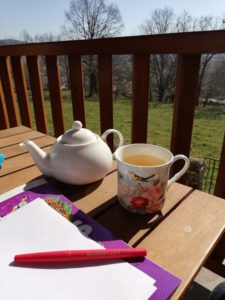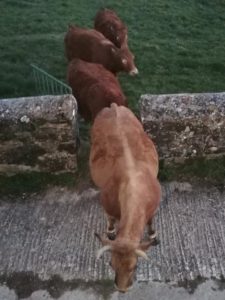 A Day in the Life…
A Day in the Life…
Katherine Bilsborough
If I’d written this blog post a couple of years ago, it would have been a lot different, more chaotic and definitely less positive. Neither the amount of work I’m doing nor the type of work has changed. Nor has the number of projects I’m working on at any given moment. But I’ve made some changes in my approach to work that have helped increase productivity, efficiency and, most important of all, sanity and personal wellbeing. This is a typical day, in as much as any day can be called typical.
7.00

I wake up to the sound of my alarm. I don’t always do this because one of the benefits of working from home and setting my own timetable is not having to be anywhere at a given hour. But sometimes I set the alarm because I want to fit in an early morning walk. I get up, have a quick cup of tea and quickly read through notes that include a lexical set and a grammar point that I need to include in a story I’m writing for a primary course book. With the language fresh in my mind, I’m hoping to get the seed of a story idea while I’m out and about walking and having a breakfast stop up the mountain.
9.00
The tactic works (it usually does) and I get home from my walk with the makings of a story, noted in an audio file on my mobile phone. This is a great way to start the working day because it means that when I begin working on the story, I’ll be able to dive straight in to the writing part when I open the file. I have my second breakfast (I always have two). Today it’s a poached egg on toast and another cup of tea.
9.30
I go into my study and open the window (it’s a nice day). The first thing I do is check my to-do list. It has three sections:
- today’s writing work (achievable units that I’ve broken down from larger projects)
- non-writing, work-related things I need to do today (emails, a Skype meeting, an invoice to prepare)
- non-work things
I’m usually working on about five things at the same time. Of these, one or two will be large, longer-term projects like a course book or a module for an online course. Others will be medium-sized such as a series of interactive activities that are part of a course book’s extra resources or half a dozen stories for the “Review” sections of another author’s course books. Then there are the smaller things like a monthly lesson plan for the British Council’s TeachingEnglish website or my monthly blog post for the National Geographic Learning In Focus blog. Articles, book reviews, preparation of webinars, talks or teacher training workshops, all fall into this category, too. It’s the variety that I love but it can get a bit overwhelming at times so one thing I’m doing more of these days is learning to say no.
I usually stay in my study for three to four hours in the morning. The first thing I did today was to write up the story I’d thought of while it was fresh in my mind. I always do this in two ways: a manuscript with instructions for artwork, design, and text, and a hand-drawn sketch of the page, with each story frame drawn in detail and text written in. I scan these sketches and send them to my editor so that she can see exactly what I’ve got in mind. And so that I can check it all fits on the page!
After a fifteen-minute coffee break (outside in the garden) I write some online interactive activities for a primary Science book. It’s very formulaic work and the sort of thing I can get done quickly as I’ve been doing it for so long. I finish and make a note to prepare the invoice.
13.00
I go out for another walk while my husband (and co-author) prepares lunch. I’m lucky that he loves cooking! This time I take a podcast as I don’t need to think about work. I’m currently listening to “The Allusionist,” a podcast about the English language. It’s entertaining.
14.15
Lunch, followed by some TV-watching. I catch up on the news and watch a political debate between candidates in the upcoming local elections in Spain. I sometimes have a 30-minute siesta after lunch but today I decided to read my book instead. I’m reading a great book called “Rest: why you get more done when you work less” by Alex Soojung-Kim Pang. It’s about the power of deliberate rest. By the time I finish it I hope to be doubly productive and working half the time.
17.00
I decide to finish an article I’ve been writing for an online magazine. It’s an opportunity to work with paper. I print off the document (on the back of some paper that has been used once already) to proofread what I’ve already written. Then I literally cut things up, move them around and finish the article on paper. It will take me about ten or fifteen minutes to finish the article on the computer but I leave it till tomorrow. It’s always a good idea to have some work waiting the next day that can just be picked up and done. This is why many great fiction writers like Haruki Murakami often stop writing when they are “on a roll.” It really works!
18.30

After a short break to help my neighbour move his cows from one field to another (that’s a blog post for another day) I’m back in my study for another couple of hours. I work on a second draft for a unit of the course book I’m writing. Yesterday I had a quick look at my editor’s comments to gauge how long the work would take. I judged it would take about an hour and a half so I set a timer on Pomodoro to see whether I was right and to stop me from sitting for too long without moving. The work takes less time than anticipated. I use the remaining time to prepare and send the invoice from this morning, to browse the NGL image library and choose a photo for my next blog post. This year’s posts are all photo-related. I’ll start my day tomorrow by looking closely at this photo so that when I go for my walk I can think about classroom activities it lends itself too.
20.30
I stop work for the day. This is early for me. Sometimes, when a deadline is looming or when I’m teaching on an online course, I work until midnight. Today I spend the evening going for a swim, doing a few chores around the house, and making some Welsh cakes. We’re expecting visitors tomorrow and they are always well received.
